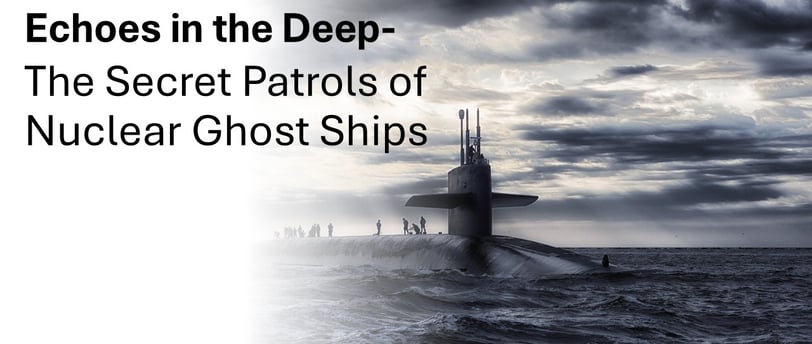Echoes in the Deep: The Secret Patrols of Nuclear Ghost Ships
They leave no wake, no trace, no sign. Beneath the surface of the world’s oceans, they glide in absolute silence—modern-day sea phantoms armed with enough firepower to end civilizations. These are the nuclear submarines, the ghost ships of deterrence, and their patrols are among the most secretive operations ever undertaken by mankind.
DEFENCE INSIGHTS
S Navin
5/12/20255 min read


Into the Abyss
When the hatch seals shut, and the crew descends into the steel belly of a nuclear-powered submarine, they vanish—not just from the world’s radar, but from existence itself. For months, these underwater fortresses sail through hostile waters, slipping beneath sonar nets, avoiding detection with surgical precision. Even their own governments sometimes don’t know exactly where they are.
To the average citizen, a nuclear submarine is a vague concept—something from Cold War thrillers or occasional headlines. But for those in uniform, particularly aboard the vessels nicknamed “boomers” (SSBNs—nuclear-powered ballistic missile submarines), they are instruments of geopolitical strategy, built not to fight, but to prevent war through the quiet threat of annihilation.
These subs don't merely patrol—they lurk. They drift through the deep, loaded with multiple independently targetable reentry vehicles (MIRVs), each capable of destroying a city. Their presence is never confirmed, but always assumed. This is the logic of nuclear deterrence: you may strike first, but you will not strike last.
Birth of the Ghosts
The origin story of these ghost ships begins in the Cold War, when the United States and the Soviet Union embarked on a shadowy arms race. The idea was chillingly simple: ensure a “second strike” capability. Land-based missiles and bombers were vulnerable to a surprise attack. But submarines, hidden in the vastness of the oceans, could survive—and retaliate.
The U.S. Navy commissioned the USS George Washington in 1959, the world’s first nuclear-powered ballistic missile submarine. The Soviets responded with their own designs, and the underwater arms race accelerated. Soon, both superpowers maintained fleets of ghost ships that could disappear for months, undetected, yet always ready to deliver a catastrophic response.
By the 1980s, these vessels were traversing the Atlantic, Pacific, and Arctic Oceans with routes so secret that even the families of the crew had no idea where they were. Communications were kept to an absolute minimum. Silence became the doctrine. Detection was death.
Life Inside a Nuclear Submarine
Imagine living inside a long, narrow, pressurized tube buried hundreds of meters below the ocean’s surface. Space is tight. There are no windows. Time is a concept that blurs under fluorescent lights. Crewmembers share bunks, rotate shifts, and operate on a schedule that few outsiders can fathom.
Psychological endurance is as critical as technical skill. Weeks can pass without any communication from the outside world. A birth, a death, a global event—none of it reaches the submerged crew unless it's deemed absolutely essential. Even then, information is filtered through strict security protocols.
One submariner put it this way: “You’re always aware you’re in a war machine. Even when nothing’s happening, it feels like you’re standing on the edge of Armageddon.”
Every crew member has a role: sonar operators listening for the faintest sound in a sea of noise, nuclear engineers maintaining the power plant that could run for decades, and weapons officers overseeing the missiles that—God forbid—could be fired with coded orders from the President.
The Mission That Must Never Be Completed
Ballistic missile submarines have one ultimate mission: to launch a nuclear counterstrike in the event of a surprise attack. But success means failure—for the only scenario where they are ordered to fire is one where cities have already been destroyed.
The U.S., Russia, the UK, France, China, and more recently India, maintain fleets of these strategic submarines. Known as “boomers” in NATO terminology and “SSBNs” in naval classification, they serve a singular role in the “nuclear triad”—the three-legged stool of land, air, and sea-based deterrence.
What makes these ghost ships unique is their near-invisibility. They operate under strict emissions control (EMCON), avoiding sonar pings, radar signals, and even internal noise. Their sound-dampening systems are so advanced that some can be quieter than the ocean around them. “Being detected,” one commander admitted, “is a tactical failure.”
Silent Games of Cat and Mouse
While these submarines are ghosts, they are not alone. In the dark underworld of naval warfare, rival submarines stalk each other in a deadly game of hide-and-seek. American SSNs (nuclear attack subs) follow Chinese boomers. Russian hunter-killers trail British SSBNs. A misstep, a misjudgment, and the cold waters could erupt in a clash no one is supposed to acknowledge.
In 2009, two of the world’s most advanced nuclear submarines—HMS Vanguard (UK) and Le Triomphant (France)—collided deep in the Atlantic. Both were carrying nuclear weapons. Neither had detected the other. That’s how quiet, how stealthy, these machines have become.
This wasn’t a freak event. It was a symptom of the invisible cold war still waged beneath the oceans.
India and the New Underwater Frontier
India entered this elite club with the commissioning of the INS Arihant, its first indigenous nuclear-powered ballistic missile submarine. It marked a turning point not just in Indian defense strategy, but in the nuclear dynamics of the Indo-Pacific.
The Arihant’s patrols are rarely publicized, but reports suggest it has already begun deterrent operations. With the ability to strike deep into enemy territory from the safety of the Indian Ocean, it enhances India’s second-strike capability significantly.
China’s own Type 094 Jin-class submarines regularly patrol near the South China Sea, while the U.S. Navy’s Ohio-class boomers roam the Pacific. With Australia’s upcoming nuclear subs under AUKUS and Pakistan's ambitions to field nuclear-capable cruise missiles from submarines, the oceanic chessboard is growing more crowded—and more volatile.
The Deterrence Paradox
Here lies the terrifying paradox: the better these submarines are at hiding, the more credible they are as a deterrent. But if no one knows where they are, how do they influence geopolitics? The answer lies in perception.
Strategists rely on ambiguity. The uncertainty of a sub’s location is its greatest strength. Just the suspicion that a nuclear submarine is patrolling a region can shape diplomatic decisions, temper military aggression, or reinforce red lines.
But this ambiguity also raises risks. Misinterpretations can lead to escalations. A sonar ping in the wrong place. A naval exercise mistaken for provocation. When nations maneuver their nuclear ghost ships into contested waters, the line between posturing and provocation becomes dangerously thin.
Echoes in the Age of AI
The future of nuclear submarines is now colliding with rapid advances in technology. Artificial intelligence, quantum computing, and autonomous drones threaten the very invisibility that these vessels rely upon.
Undersea sensor networks, satellite wake-tracking, and low-frequency sound surveillance are becoming more sophisticated. The idea of “transparent oceans” is no longer science fiction—it’s an emerging possibility.
In response, navies are developing countermeasures: cloaking technologies, improved hull coatings, and deeper diving capabilities. The game is evolving, but the stakes remain the same—total destruction if deterrence fails.
The Human Burden
Amid all this technology and doctrine, it’s easy to forget the human cost. The men and women aboard these submarines shoulder an unspoken psychological burden. They live with the knowledge that, at any moment, they could be called to initiate the end of the world as we know it.
In interviews, many submariners reveal a quiet fear—not of death, but of moral responsibility. “You train to turn keys,” one former missile officer said, “but you pray you never have to.”
And when they return from their months-long patrols, there are no parades, no headlines. Just decompression time, reintegration, and another countdown to the next silent voyage.
Ghosts Will Always Haunt the Deep
In a world teetering on the edge of great power rivalry, these underwater phantoms continue to patrol the vast, cold oceans. Their patrol routes are classified. Their movements are deniable. But they are out there—always out there.
As long as the doctrine of nuclear deterrence exists, so too will the need for these ghost ships. They are not merely machines of war; they are guardians of an uneasy peace. Their silence is not absence—it is presence, felt in every geopolitical calculation, every national security briefing, every moment of calm between potential storms.
Echoes in the deep aren’t just sound waves. They are warnings. They are memories. And sometimes, they are the only thing keeping us from the brink.
